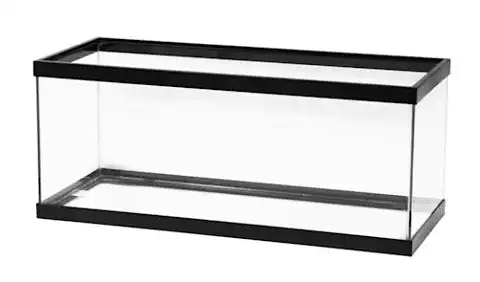Thank you for visiting! By the way… any links on this page that lead to products on Amazon and other stores/partners are affiliate links Aquarium Store Depot earns a commission if you make a purchase.
Have a lonely and bored betta fish? Want to fill up the extra space in your betta tank?
You may be able to keep both male and female bettas in your aquarium given the right setup. For a long time, it was believed that male and female betta fish should be kept far apart. Hobbyist experience tell otherwise.
Find out how to set up your betta fish tank to house male and female bettas together indefinitely! Let’s answer the question of can a male and female betta live together!
Key Takeaways
- The quick answer is generally no, however it is possible in the right setup
- It is possible to house bettas together in the same tank as long as personalities match and the aquarium is set up specifically for keeping multiple bettas.
- Temperament, tank mates, introduction methods, water quality, and diet can be controlled to keep male and female betta fish together with minimal to no aggression.
- Two to three female bettas should be kept per every one male betta fish. A large tank will leave room for territories to be established, but these small fish can be comfortably kept together in nano aquariums.
- Adding other tank mates, like harlequin rasboras, may help distract more aggressive bettas.
Introduction
It was originally believed that no other fish could live in the same tank alongside betta fish of the Betta splendens species. Over the years, aquarium hobbyists bent the rules and added an assortment of plants, invertebrates, and eventually, other tropical fish. While many times these betta combinations ended up in dead fish, every once in a while, there would be a success.
As more time went on, hobbyists learned which species were compatible and the best ways to introduce them to aggressive bettas. Now, fishkeepers are pushing the betta boundaries even more by trying to keep male and female bettas together indefinitely in the same aquarium.
Can A Male and Female Betta Live Together in the Same Tank?
For a long time, it was believed that male and female bettas should only be together in the same tank for breeding purposes. While this is still largely true, a handful of hobbyists have had luck keeping pairs, harems, and groups together in slightly larger tank setups.
There are a few factors that go into determining whether or not these pairings will be successful. These include temperament, tank setup, tank mates, introduction methods, water quality, and diet. We have a video from our YouTube channel above that gives you a few examples of this combo being successful and we go into more details below in our blog. If you like our content, be sure to subscribe as we post new videos every week!
Why is Your Male Betta Attacking Your Female Betta?
While some male and female betta fish live together with no problems, others are incompatible no matter what you do. In most cases, the male is aggressive towards the female, but sometimes the female can be overly dominant as well.
This aggression usually stems from an overlap in territories, breeding times, or the individual personalities of the fish. No matter why your male betta is attacking your female betta or vice versa, the fish should be separated as soon as possible.
Can You Keep 2 Female Betta Fish Together?
While many hobbyists like to mix males and females, what if you just want to feature two female betta fish? This isn’t quite a betta sorority, but rather, a peaceful pairing of two bettas.
Yes, two female betta fish can live together as long as the personalities of the fish match and the tank is set up correctly. Female bettas can be just as aggressive as their male counterparts, so it’s best to purchase related bettas or ones that were raised together. The tank should also have plenty of swimming space but filled with vegetation and hiding places that break up lines of sight.
If anything, a glass or plastic tank divider can be used to separate these two betta fish without any risk.
Temperament
Naturally, betta fish do not want to be aggressive toward one another. If you think about their secluded natural habitats in seasonal floodplains and rice paddies, being overly aggressive and defensive to the point of death would greatly impact the overall population; a limited number of available fish in an environment should not be made smaller through intraspecies competition.
One of the main reasons domesticated bettas are so aggressive in the aquarium hobby is due to selective breeding. Many lineages of betta fish were intentionally bred to demonstrate the most aggression for fighting purposes, hence their secondary common name of Siamese fighting fish. It’s also been determined that certain colors of betta, namely those with red pigment genetics, have more of an aggressive nature than others1.
While you can try to pick the most natural, wild-type-looking Betta splendens to reduce the chances of aggression, compatibility will largely be up to the individual bettas involved. If you’ve ever owned betta fish before, you will know that no two are the same. Each fish has its own personality that can be bold and expressive or shy and reclusive. Either extreme of this range can result in incompatibility.
Ideally, you want male and female betta fish that are alert yet relaxed. They should be inquisitive but not defensive. If you have overly curious or offensive fish, then there are a few ways to diminish unwanted aggressive and territorial nature through your aquarium setup.
Tank Setup
Think about a betta’s natural habitat again. In addition to being small, betta fish live together in densely vegetative areas. The water is usually stained by tannins from organics with tons of kicked-up sediment. Add in the plant life and visibility is greatly reduced.
These same conditions should be replicated in a betta fish tank with plenty of live plants and structures that break up the line of sight between each betta. When keeping more than one betta fish together, you need to make it easy for territories to be established and later maintained. One way to do this is by creating walls of foliage, like with Java moss (Vesicularia dubyana), between wooden or rock structures.
One of the easiest mosses to grow in an aquarium. Great for small fish and shrimp
Though this unkempt environment won’t look polished like most other heavily planted aquariums, your betta fish will be much less willing to fight each other. On top of adding lots of natural coverage and hiding places, lighting can be dimmed and organic tannins may also be added to stain the water and darken conditions.
Contrary to popular belief, adding additional tank mates can also keep male and female bettas calm as long as tank size allows for additional fish. The minimum tank size you will want to consider for multiple Bettas is 20 gallons, with a 20 gallon long being the only viable option at that size. A 29 gallon or larger is preferred. Heavily planted setups are also recommended.
A classic 20 gallon aquarium in its 30 inch long variant. A very popular aquarium.
Tank Mates
Rarely has the answer to aggressive fish ever been adding additional fish. But believe it or not, having dither species, or bold and active fish that are used by other fish to determine environmental conditions, can help bettas feel more relaxed.
This mentality follows as: if the dither fish are relaxed, then there must be no threat present and the betta can also relax. Dither fish can also increase activity from betta fish and make shy individuals more likely to be in the front of the tank.
Some of the best betta fish dither fish include livebearers, tetras, and danios. Make sure that these fish don’t outcompete your bettas during feeding times. For the best results, it’s recommended to feed your fish in separate areas of the tank, with one species receiving floating fish flakes with others getting sinking pellets. This should help lessen competition and decrease the chances of aggression arising during feeding times.
Still, always watch while your female and male bettas eat as this is when aggression is most likely to show.
How Many Bettas Can Live Together?
In regards to betta fish as their own tank mates, there is a balance that needs to be achieved. At least two to three female betta fish should be kept per every male betta. This will prevent the male betta fish from overpowering the females while also limiting aggression between other males. This should only be attempted in a larger tank.
How Many Bettas Can You Have In Your Tank, Though?
A lot, actually. If things go well, betta fish are small fish that have adapted to living in small spaces. Hobbyists have successfully kept upwards of five betta fish in a 20 gallon tank with one male betta and four female bettas; for nano tanks, it’s recommended to only keep one male betta fish.
As tank size increases, so does the possible number of betta fish. Keep in mind that the more fish you add, the greater risk you’re imposing on your fish.
Introduction Methods
How you introduce your male and female betta fish to one another will get you started on the right foot. There are a couple of ways to introduce these fish with varying success.
- Introducing them all at the same time. This is the most agreed-upon method for successfully introducing aggressive fish to each other. Putting all the fish together in the same tank at the same time allows for equal competition to establish territories; there is no opportunity for a dominant female or male to claim and defend their own space in the aquarium. Instead, every fish comes in stressed and then relaxes over time. Unfortunately, this method doesn’t always work. Naturally, some fish are bigger and more aggressive than others. This can still lead to outlying fish that get bullied and harassed by other fish. If using this method, be prepared to remove and rehome less dominant fish.
- Introduce additional fish over time. If you’re not able to add all your bettas at the same time, then you might need to add them slowly over the course of weeks or months. This method can be more challenging than introducing all betta fish at the same time as territories and dominance levels are already established; adding a new fish into the mix can upset hierarchies and make fish feel pressed for space, which can result in aggression.The best way to introduce new male and female betta fish to one another is by using a tank divider. This allows the fish to become familiar with each other without threat to their safety; if your fish don’t react well to one another’s presence, then there’s a good chance things won’t go well once the tank divider has been removed.
In addition to these introduction methods, there are other ways in which you can improve the compatibility between your male and female bettas. One way is to purchase related fish. Male and female betta fish that are related and have been raised together are much less likely to be aggressive. This is not always true though and overaggression is still possible.
This is especially likely to happen if mature male bettas are added with mature female bettas. When ready, a male betta will create a bubble nest in preparation to mate. This mating ritual can be intense for the female and has resulted in serious injury during and after the process. As we’ll see, keeping male bettas from initiating the breeding process is safest for all fish involved.
Another way to help guarantee compatibility is by purchasing a pre-formed betta harem. Betta harems have become increasingly popular over the years as hobbyists have figured out how to make them work. These harems consist only of females, which reduces some chance of aggression–don’t be fooled though, female betta fish can be just as aggressive as male bettas (video source).
No matter which introduction method you use, you should always be prepared to move fish to separate tanks if need be.
Water Quality
Water quality plays a big part in whether or not male and female betta fish live compatibly in the same aquarium. As mentioned before, it’s ideal to create conditions that don’t encourage breeding. Breeding betta fish is an intense and sometimes dangerous act that can cause injury to both fish involved.
In this process, male betta fish create a bubble nest at the surface of the water. They then select a female betta fish to entangle and fertilize her eggs. However, the male fish may chase, nip, and even attack female bettas whether they’re ready or not. If successful, the fertilized eggs will begin to fall to the substrate. The male betta fish will catch them and safely put them in the bubble nest. He will continue to protect this nest with his life, including from other betta fish, until they hatch.
The mating season is initiated when conditions are favorable. Remember, betta fish live together in temporary bodies of water that can quickly disappear. This is usually when water temperatures are highest, with plenty of vegetation and insects available for fry to eat.
In the aquarium, male and female betta fish are often moved to a separate breeding tank where conditions can be controlled to simulate these rises in temperature; a separate tank also allows for easy removal of the female betta after mating has finished. Most times, these favorable conditions occur between 80-82° F.
In order to keep male and female betta fish from mating in the aquarium, and thus increasing possible aggression, it’s recommended to keep the water temperature slightly cooler at 75-78° F. Other parameters should be held in their optimal range with both ammonia and nitrite at 0 ppm, minimal nitrates, and pH between 6.5-8.0.
Even more important is keeping these parameters stable. While temperature fluctuations are the leading influence on breeding bettas, other parameter swings can also cause betta fish to initiate the process. Water parameters should remain as stable as possible through close monitoring and water changes.
Water changes should also be more regular than in a regular betta fish tank. This is because both male and female betta fish release pheromones that are attractive to one another, further increasing the likelihood of breeding. Luckily, these pheromones are easily removed during weekly tank maintenance.
Diet
Lastly, diet can play a huge role in whether or not your male and female betta fish live together harmoniously. Here’s how to control feeding time and food selection so that your fish live together indefinitely and not only just for breeding.
Diet is often used to influence breeding. Providing a high-quality, protein-rich food selection is a popular method for hobbyists to use to encourage spawning. While it’s still recommended to give your male and female fish the best food possible, live food is especially preferred. Live food, like insects, bloodworms, and shrimp, distracts your betta fish while providing enrichment. If they are too concentrated on a delicious meal, then there’s no time to be aggressive toward each other.
Live food can be expensive and fattening, though, and can’t be given for every feeding. Instead, a high-quality flake and/or pellet can be given at different locations and depths of the aquarium. This is especially true if you have other species that might outcompete your bettas during feeding times.
Best Betta Food
Fluval bug bites is made of various insect and shrimp ingredients making this a high quality source of protein
In addition to providing live food, feed regularly. Again, this will give the fish something to look forward to and participate in as opposed to fighting.
Conclusion
Yes! It is possible to keep multiple bettas in the same tank–in fact, a group of betta fish can be successfully kept in relatively small aquariums as long as the tank setup is designed with them in mind. These kinds of betta tanks can be used to house a female sorority or a couple of males with several females.
Every fish has its own personality and some combinations won’t work no matter what you do. If you are patient and diligent about your fish’s needs, then there’s a good chance you can keep male and female betta fish together for the long term!
- About the Author
- Latest Posts
I’m thrilled that you found Aquarium Store Depot! Here you’ll find information on fish, aquariums, and all things aquatics related. I’m a hobbyist (being doing this since I was 11) and here to help other hobbyists thrive with their aquariums! I adhere to a high quality Editorial Process and Review products with real life field usage and practical analysis.








